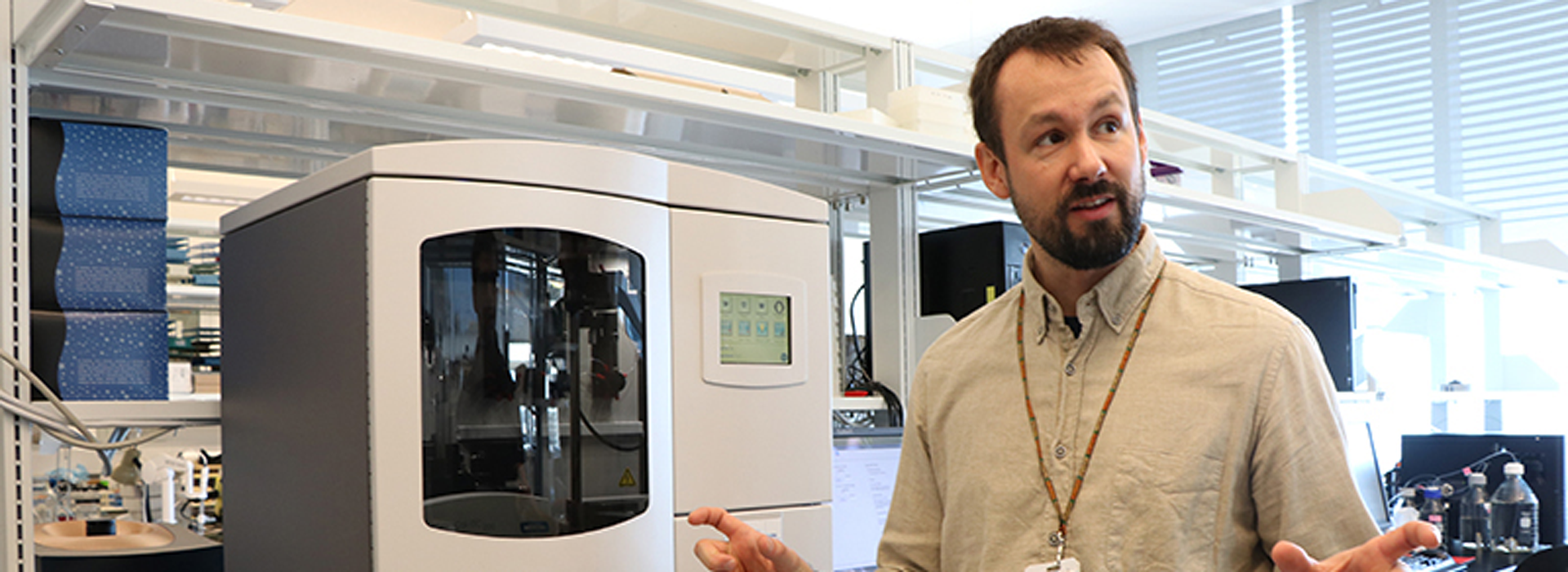By: Jon Farrow
5 Nov, 2019

Meet 2019 CIFAR Azrieli Global Scholar Jean-Philippe Julien, who uses robots to design better vaccines.
Jean-Philippe Julien, a 2019 CIFAR Azrieli Global Scholar joining the Molecular Architecture of Life program at CIFAR, is a researcher at the University of Toronto and the Hospital for Sick Children who sees antibodies as the heroes of the immune system.
“The theme in my laboratory is the power of the antibody,” he says. “I’m interested in the power of the antibody to neutralize a virus or to recognize a tumor cell and recruit the body’s defense to kill it.”
Julien examines antibodies and the cells that make them at the atomic level in order to find just the right ingredients for next-generation vaccines and cancer treatments. But Julien doesn’t do it alone. He enlists the help of a team of talented students, trainees, and robots.

Vaccines work by presenting a harmless form of a pathogen to your immune system so that your body can learn how to recognize that pathogen. “You’re trying to teach your immune system how it should respond and what type of antibodies it should make,” explains Julien, “so that when it encounters the real threat, then it’s already able to protect you and you don’t get infected.”
A type of white blood cell called a B cell is integral to this process. They learn to produce antibodies, small proteins that bind to the pathogens and signal to the rest of the body that an invader has been spotted. One B cell will learn to produce one type of antibody, which in turn will be effective at recognizing one foreign element found on the surface of the invading pathogen.
This works in principle, but if the pathogens mutate and the protein the antibody is targeting changes, then even when B-cells are perfect students, they can fail the test. Influenza vaccines, for example, are notoriously hit-and-miss. In a given year, a flu shot may only protect half of the people who get it. (Flu vaccines, despite their varying efficacy, are still worth taking. They prevent hundreds of thousands of hospitalizations and deaths every year). This is because there are many different strains of influenza all over the world, which are rapidly evolving and changing.
Julien points out, however, that the flu is stable compared to viruses like HIV. “All the diversity of influenza all over the world in one year doesn’t even match the diversity of HIV in one person at one given time,” he says.
“That’s the biggest challenge. So what do you need to put in your vaccine so that you’re not only able to teach someone’s body to recognize one virus of HIV, but all the different viruses circulating in one individual and all individuals around the world?”
Much of the work in Julien’s lab is devoted to understanding the structure and function of B-cells and antibodies. He investigates, on an atomic and molecular level, their different components and how they fit together.
Growing up in a family in the construction business in Northern Quebec, Julien draws inspiration from the blueprints he would often see at home. “When you do structural biology,” he says, “and you see how molecules move, and how atoms create an immune response, then you can start to design with really high precision. You’ve obtained the blueprints.”
To hunt for potential vaccines against HIV and Malaria, Julien’s lab studies hundreds of antibodies, each with slightly different chemical and physical characteristics. Evaluating every molecule in such a library by hand would be difficult and error-prone, so to speed up the search for effective conditions, they use robots.
The robots don’t mind staying up all night methodically dripping liquids into wells on a plate. They will even work on the weekends.
“Back in the old days,” Julien explains, “that was a big part of a graduate student’s job.” Now, with robots able to go through thousands of times more conditions than a human to see what works, trainees are freed up to hypothesize, follow up, and create.
When a potentially interesting condition is found, it is flagged by the research team, who can verify the result and start the next battery of tests.
As a CIFAR Azrieli Global Scholar, Julien will join the Molecular Architecture of Life program for a two-year term. He is particularly keen to fit his work on B cells into the wider problem of immunity and infection.
“How do you take your discovery or your approach and integrate it in the bigger picture of world challenges? There are so many techniques that are being used. And no one individual, I think, masters all of them,” he says. “So in the Molecular Architecture of Life program are some of the world leaders in these structural biology techniques. I’m excited to be able to join the program, and not only learn how to best use and integrate the tools that are here today, but to design the best tools for the next 10 to 20 years.”